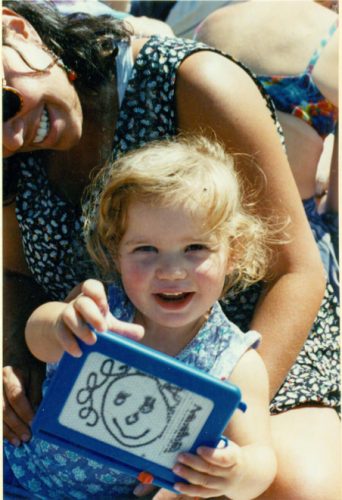
In 1994, I was one year old, sitting in the grass wearing a blue floral dress and eating a Ben and Jerry’s Cherry Garcia Peace Pop. This made sense: Like many children of Deadheads, my parents had brought me to the Grateful Dead show at Autzen Stadium on June 17, 1994.
My parents met in the summer of ’88 on their way to a Dead show at Autzen. My mom had never been to Oregon and needed a ride from Los Angeles; my dad gave her one.
Five years later, I was born and they were taking me to Grateful Dead concerts.
Growing up, the Grateful Dead held a strange mythological sway over my parents. My dad attended around 100 shows and sold about 1,000 pink tie-dye shirts that had Charlie Brown wearing a shirt with the Steal Your Face emblem — the Grateful Dead’s signature lightning bolt in a skull icon that comes from their 1976 album. The shirts read “Mr. Charlie Told Me So.”
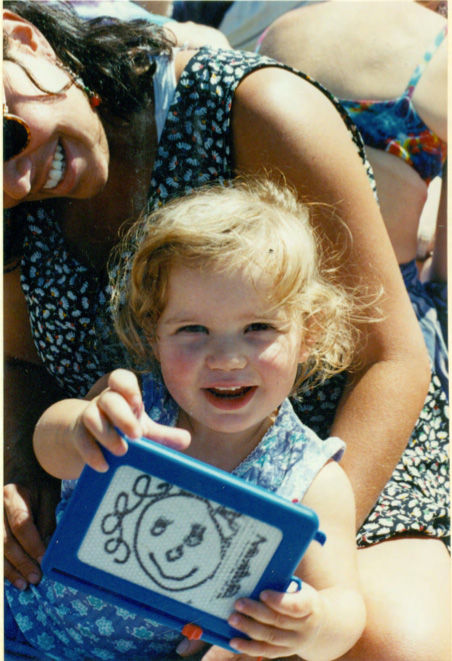 |
| The author Sophia June with her mother at the 1994 Autzen Grateful Dead show |
When my brother was born in the Eisenhower Medical Center adjacent to the Betty Ford Center in Rancho Mirage, California, in July of ’95, Jerry Garcia was there for drug rehab. When he died a week after my brother was born, my parents joked that Garcia had put a spirit in him.
My dad tells stories about driving from Boulder, Colorado, to San Francisco in one night for a weekend of Grateful Dead shows, “but we were kind of crazy,” he admits. My mom uprooted her life as a grad student in San Diego to eat veggie burritos and follow the band as far as Kansas City, Missouri. “We went on tour,” my parents like to tell me.
Jerry Garcia himself famously said, “Our audience is like people who like licorice. Not everybody likes licorice, but the people who like licorice, really like licorice.” Deadheads are the people who gobble up, dissect the meaning of and build lives around that licorice.
Despite the numerous signifiers surrounding its cultural status — as both a cult and mainstream rock band — nothing better illustrates the band’s current relevance than the Fare Thee Well shows, June 27 and 28 at Levi’s Stadium in Santa Clara, and July 3-5 at Soldier Field in Chicago. Hi-Fi Music Hall will be streaming the shows live for free, because let’s face it — Eugene is obsessed with the Dead.
But judging by the Dead’s tour history, it seems this obsession isn’t entirely one-sided.
The Grateful Dead have played Autzen Stadium 10 times, Mac Court three times, the Hult Center, South Eugene High School, the EMU Ballroom and Lane Community College, not to mention the 1972 “Sunshine Daydream” show, also known as “The Field Trip” show, at the Oregon Country Fair grounds that funded the Springfield Creamery. Jerry Garcia’s ex-wife Carolyn Garcia even relocated to Eugene and still lives here today.
So grab the kids and settle them in for a story. Let’s take that long strange trip of how our small city south of Portland gained a reputation for being the Dead’s second home, and how that legacy thrives today.
YOU’RE GONNA MISS ME WHEN I’M GONE
May 5, 1965, was the Grateful Dead’s first paid gig, a show at Magoo’s Pizza Parlor in Menlo Park, California, back when they were still called The Warlocks.
Half a century later, in January 2015, Trixie Garcia, Jerry’s daughter, announced that the world’s most influential jam band would be reuniting for three last shows to celebrate its 50th anniversary. This is the first time Bill Kreutzmann, Bob Weir, Mickey Hart and Phil Lesh would play together under the name the Grateful Dead since the 1995 death of frontman Jerry Garcia. Much to the chagrin of Deadheads on both coasts, however, the shows were scheduled to occur in Chicago’s Soldier Field — the site of Jerry’s last show.
The announcement didn’t create just a ripple, but a whirlpool in the Dead sea of fans.
The Grateful Dead decided to release tickets just as they did in the ’80s and ’90s: Fans could decorate envelopes requesting tickets and send them via post. (Many of these envelopes are now held in the Grateful Dead archive at UC Santa Cruz.)
In January 2015, the post office, located in Stinson Beach, California, received 60,000 envelopes, with more than 400,000 ticket requests. According to The Wall Street Journal, the post office usually receives 7,000 letters a week.
Fans who couldn’t snag tickets through mail order could try to buy through Ticketmaster starting Feb. 28.
That Saturday, half a million people logged on to gobble up any of what was left of Soldier Field’s 61,500 seats. Unfortunately, scalpers bought most of the tickets and posted them on StubHub, with prices ranging from $587.50 for an obstructed view to $116,004 for a three-day pass, The Wall Street Journal reported.
Compare these astronomical prices with the face value of the tickets: $59 to $199. Adding insult to injury is the fact that the last time the Grateful Dead played, online scalping didn’t exist — and you have a lot of angry Deadheads without tickets.
In response, on April 13, the band announced two additional farewell shows in Santa Clara, California, stating that they needed to say goodbye to their Palo Alto and San Francisco roots.
Closer to home, Deadhead culture is alive and well in in the greater Eugene area. A majority of the merchandise at Lazar’s Bazar seems to be Dead-themed. In fact, a 1995 Register-Guard article detailing Garcia’s death, called Lazar’s “Eugene’s unofficial Grateful Dead store.” Grateful Dead fans came into the store crying in the days after Jerry’s death. Then there are the folks outside Autzen who sell green and yellow tie-dye shirts emblazoned with the Steal Your Face at football games.
Deb Trist, aka Downtown Deb, has hosted the Grateful Dead show, KLCC’s Dead Air, for more than 20 years.
Take a look at the lineups for local venues and see The Garcia Birthday Band at Cozmic, Hardly Deadly at Axe & Fiddle in Cottage Grove and Grateful Dead Wednesday at Happy Hours bar on River Road. There are four Grateful Dead tribute bands based in Eugene and five in Portland. Chicago’s famous Dead tribute band, Dark Star Orchestra, never misses Eugene on its annual tour.
There’s a Jerry Garcia mural on 14th and Willamette Street. In an interview with 1859 Oregon Magazine, business owner Mike McMenamin even cited the Grateful Dead as inspiration for McMenamins.
The Grateful Dead’s former chef, Ray Sewell, owns the Eugene coffee line — Chez Ray’s Headliners’ Organic Coffees — which has four coffees dedicated to the Grateful Dead.
Look around: On any given day on any Eugene street, chances are you’ll see the Dead’s influence, from dancing-bear tapestries in windows to skull stickers slapped on bumpers of rides as varied as VW buses and BMWs.
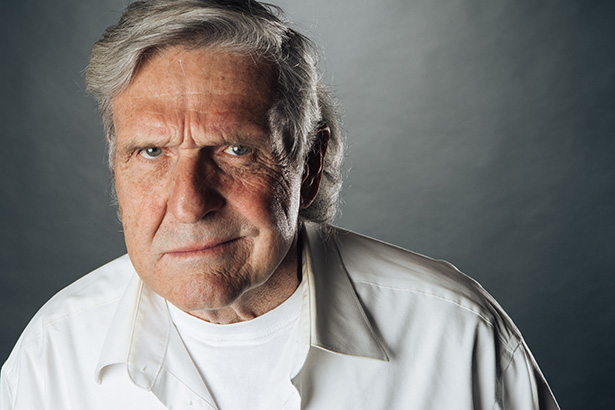 |
| Ken Babbs. Photos by Todd Cooper. |
THE KESEY CONNECTION
Arguably, no two people are better suited to speak on behalf of Ken Kesey’s connection to the Grateful Dead — and consequently, the Grateful Dead’s connection to Eugene — than Ken Babbs and Sunshine Kesey.
Babbs — who famously appears in Tom Wolfe’s The Electric Kool-Aid Acid Test — is one of the original Merry Pranksters, the band of miscreants who boarded Ken Kesey’s psychedelically painted Furthur bus and promoted the use of LSD.
Babbs met the Dead in the early ’60s during the first San Francisco Acid Tests, a series of parties that blended LSD experimentation with multimedia light shows, videos and live music.
Even in his 70s, Babbs possesses a youthful energy, bursting into loud guffaws and even singing loudly during our interview at Vero Espresso House.
“We all went outside the house and we were standing in a circle out there and baying at the moon and holding hands and jumping up and down, and we heard this music coming from the house,” Babbs says. “Like, ‘Wow what’s this?’ And so we went into the house and looked and there were these hairy musicians all playing our instruments.”
The Warlocks soon became the house band for the Acid Tests. Babbs witnessed the creation of their iconic new name.
“They got out the Egyptian Book of the Dead and sat around the table, and Jerry Garcia put his finger on this line and read it out loud, and it was: ‘The chariot of the sun is pulled across the skies by the grateful dead,’ and so from then on …” he says.
Babbs explains that the gang came to Oregon after Kesey was busted for drugs. After doing time at a work camp in San Mateo, California, Kesey bought a farm in Pleasant Hill.
“We were doing all that work in San Francisco. It was fun, but when it was time to come up to Oregon, it was great. This is the place,” Babbs says. He also attributes this Oregon migration to San Francisco’s overcrowding in the ’60s.
“People really migrated out of there to the country; a lot of them came up here. There were a lot of communes right around here. And so those were the people who were kind of the foundation for that Deadhead hippie scene here. And of course, infused with the college kids, so Eugene has always been a neat town because of that,” he says.
As princess of America’s royal hippie family, Sunshine Kesey personifies the Eugene connection between Kesey and the Dead.
Sitting at Espresso Roma, a spot she frequented as a UO student in the early ’90s, Sunshine Kesey is aptly named, with blonde, curly hair, Ken Kesey’s blue eyes and what I imagine Jerry’s personality to be: mellow, peaceful and intellectual.
Growing up with Jerry Garcia as a father figure, Carolyn Garcia (known as “Mountain Girl” in Wolfe’s Acid Test) as a mother and Ken Kesey as a biological father, Sunshine Kesey spent her youth travelling back and forth between the Grateful Dead camp in San Francisco and the Kesey farm in Pleasant Hill. She attended the UO and still lives in Pleasant Hill today.
“It was pretty tribal, you know, there’s lots of family ties,” Kesey tells EW. “Because they all got to know each other during the whole Acid Test time, and so they were sort of bonded. The whole Grateful Dead scene and the whole Prankster-Country Fair-Eugene connection was pretty strong.”
Culturally, Sunshine Kesey draws a connection between the Bay Area’s Marin County and Eugene, calling Eugene a “little sister city,” especially for the nomadic aging hippies ready to forgo acid for baby formula.
“And my dad too,” she says, “he fostered that because he had a big farm and he would encourage people to come and stay and just experience being out on the farm. He was always willing to host people. He was one of the stops on the underground railroad to getting ‘more free,’ or whatever, so people would come there all the time and sometimes stay awhile.”
Ken Kesey was the first Prankster to migrate to Oregon. When others followed, an Oregon scene was established that eventually brought the Dead, too.
“When you talk about Eugene and the Grateful Dead, there’s really a heavy footprint there,” Babbs says. “So when they’d come here it was like ‘Oh boy,’ there was sort of a feeling that they were one of us and we were one of them.”
But it was the August 27, 1972, “Field Trip” shows at Oregon Country Fair grounds that solidified the Eugene-Dead bond. The relic of this show still exists in Sunshine Daydream, a 2013 rock documentary using Babbs’ video footage. Judging by the film’s shots of the crowd, it looks like it could have been filmed this summer, sharing uncanny similarities in terms of nudity, crotchet clothing and shaggy children running wild.
“The biggest, biggest scene of all was in 1972 when they did the concert out at Oregon Country Fairgrounds out in Veneta, a benefit for the Springfield Creamery,” Babbs recalls.
This is the same Springfield Creamery owned by the Kesey family, behind the creation of Nancy’s Yogurt. Twenty thousand people came to Veneta to see the Grateful Dead, even in 107-degree weather. The Creamery was struggling financially but able to stay in business from the show’s proceeds. The Grateful Dead played the Fair again in 1982.
A LINGERING SPIRIT
Perhaps the most obvious Dead legacy in Eugene isn’t even The Garcia Birthday Band or KLCC’s Dead Air Radio, but Eugene’s ethos, the lingering energy of the hippie movement manifesting itself in Eugene’s DIY culture.
Sunshine Kesey believes the connection between the Grateful Dead and Eugene is most vital in what the Deadheads have created since.
“They have stayed here and actually made homes and had children and made little health food stores and hempy clothing — you know, they did it,” she says. “They had their little epiphanies out there running around young and wild and doing exactly what their parents wish they wouldn’t.”
Kesey equates this individualistic energy to the way the Grateful Dead managed their band, creating their own publishing company and allowing fans to tape shows.
“A lot of people wanted to do it their way and that was one of the things the Dead did, was do it their way,” Kesey says. “They just decided to take ownership of themselves, and to me, that’s what the hippie movement is: being self-determined and as self-sufficient as possible.”
Deb Trist, host of Dead Air, was married to Alan Trist, manager of Ice Nine Publishing Company, the Dead’s publishing, royalties and copyright company. After meeting the band in 1972 and working part time in the Grateful Dead office for several years, Trist moved to Eugene at the end of 1983. She’s been hosting Dead Air since 1986, airing on KLCC since 1991.
Trist says she believes the Grateful Dead music reflects a specific time in history, one of independence, improvisation and free spirits.
“Oregon is a pioneer community; the Dead are also that,” she says. “To me, it’s the last great American adventure.”
Besides Eugene’s ethos, legacies of the Grateful Dead are seen in people who have made their livelihoods in the music. Arthur Steinhorn, drummer for Garcia Birthday Band, is one of these people.
“There’s healing and magic and ‘I needed this’ and ‘it means so much to me,’” Steinhorn says. “And it’s the same for me, I need it every week. It’s a special thing we know we have and it goes beyond the music. The music is the medium in which we can bring people together.”
Steinhorn says the band pays close attention to its Eugene shows, because of the people and history here.
“Eugene does have its own quality of Heads down there that’s different than a lot of places,” Steinhorn says. “It is a deep-rooted Grateful Dead community. The expectations are higher in playing Eugene than other places.”
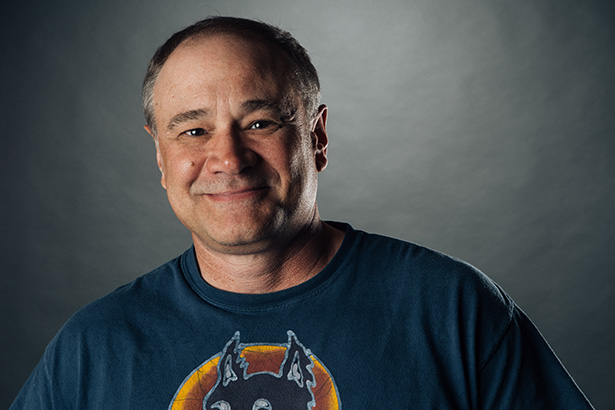 |
| Jason Johnson. Photo by Todd Cooper. |
THE MUSIC NEVER STOPPED
While the Fare Thee Well concerts have been wildly popular with Grateful Dead fans, some have mixed feelings.
Sunshine Kesey will be attending the shows in Chicago, but has expressed some qualms.
“What would it be like if somebody has been divorced for the past 20 years, and they decide to get together for one final thing because it will make some good money and it will be a fun party?” Sunshine Kesey says. “But they’re not going to stay together after that. It’s kind of odd.”
Despite her reservations, Kesey says she is excited to attend the shows and reconnect with her Grateful Dead family.
“I’m sure Jerry would be thrilled that they’re still making music. It’s what he lived for, you know?” Kesey says. “I’m proud of everybody for pulling it together.”
Eugene businessman Jason Johnson is the former executive director of Eugene’s Furthur Down The Road Foundation, an organization dedicated to restoring Ken Kesey’s Furthur bus and educating kids about the author. Johnson is also an army officer turned Deadhead who, like many before him, migrated from a fast-paced life in California to a simpler one in Oregon. Johnson speaks with a Tennessee drawl and can’t stop smiling when talking about the Dead and scoring tickets to the Soldier Field shows.
“The ripples from the Grateful Dead and from Kesey and from Eugene have really permeated every corner of the world and the Deadheads that I’m friends with that I’m going to see in July are from all walks of life,” he says. “There’s consultants and politicians and military guys … and they all come together to speak this one common language, and they know it as the Grateful Dead.”
With dedicated fans like Johnson, it seems the legacy of Grateful Dead will live on forever.
“It has grown beyond everybody’s wildest dreams, and this whole selling tickets to the Fare Thee Well was a huge eye-opener for everybody,” Sunshine Kesey says. “This is not a dwindling thing.”
In a way, the music of the Grateful Dead has already proven its temporal resilience through the decades. The same band that formed when my mom was 6 became the one that led her to meet her husband. And though the band hasn’t released any new music for 25 years, they still received 400,000 paper requests for tickets in 2015.
“As long as Deadheads keep having kids, it’s all good,” the Garcia Birthday Band’s Steinhorn says. “I see good things ahead for many generations.”
Even when the Grateful Dead are silenced, the community doesn’t die. Eugene has seen this borne out: The Dead were temporarily banned from playing Autzen Stadium in 1991 because the UO didn’t want to be seen as promoting drugs. Deadheads responded by protesting at the Wayne Morse Free Speech Plaza near the old Federal Courthouse. The band returned to Autzen in 1993.
By letting people record their shows and post them online, fans will forever be able to relive the music. Just think, on the UO campus, people can put on some headphones and jam out to a recording of the 1969 Dead show at Mac Court as they walk by it.
“There’s an enduring spirit,” says Trist of Dead Air. “It’s indescribable. When you hit the music, it’s the soundtrack of people’s lives.”
The Grateful Dead are the reason I am alive, and millions more have been given spiritual life through their music. My parents eventually divorced, which for me, makes the Grateful Dead even more meaningful: They are the one thing besides my brother and me that will always connect my parents. My dad, following a Dead tour in 1987, is just a microcosm for what millions of fan’s relationship with the Dead is — in his words, “the adventure of a lifetime.”
[Editors note: The article originally stated that WOW Hall would also be simulcasting the Grateful Dead shows July 3-5. They have since cancled the simulcast due to licensing fees.This article orginally stated the Dead were banned from Autzen in 1990. The ban was announced in 1990, but it was for the 1991 show. It also stated they played Autzen five times. The band played Autzen 10 times.
*It should be noted that there are different theories about the origin’s of the Grateful Dead’s name. Deb Trist points out that Phil Lesh wrote in his autobiography that the band picked the term from a Funk & Wagnalls folklore dictionary.]
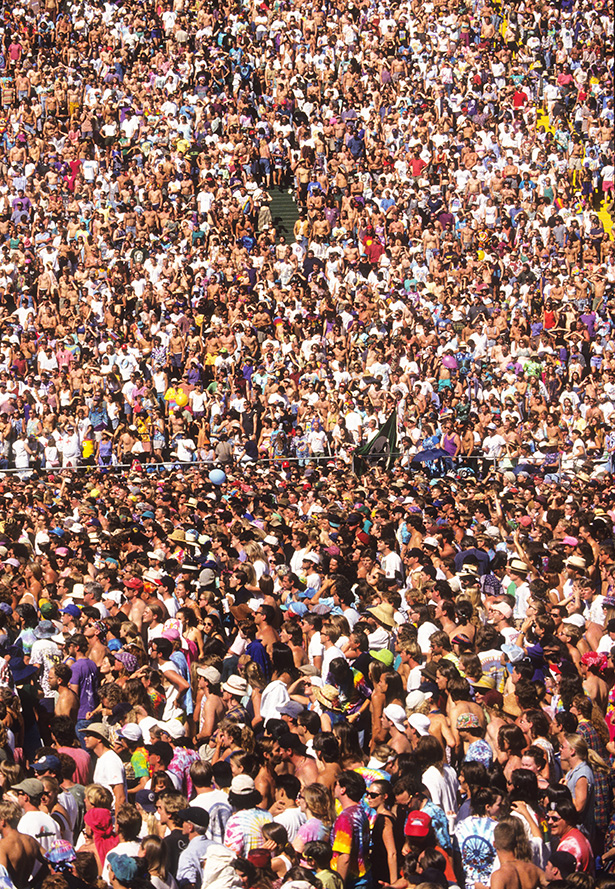 |
| The crowd at the Grateful Dead’s Autzen Stadium show in 1993 |
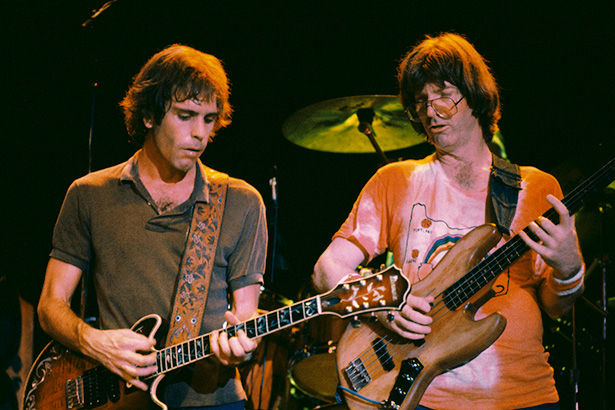 |
| The Grateful Dead perform at McArthur Court Aug. 16, 1981 |
A Note From the Publisher

Dear Readers,
The last two years have been some of the hardest in Eugene Weekly’s 43 years. There were moments when keeping the paper alive felt uncertain. And yet, here we are — still publishing, still investigating, still showing up every week.
That’s because of you!
Not just because of financial support (though that matters enormously), but because of the emails, notes, conversations, encouragement and ideas you shared along the way. You reminded us why this paper exists and who it’s for.
Listening to readers has always been at the heart of Eugene Weekly. This year, that meant launching our popular weekly Activist Alert column, after many of you told us there was no single, reliable place to find information about rallies, meetings and ways to get involved. You asked. We responded.
We’ve also continued to deepen the coverage that sets Eugene Weekly apart, including our in-depth reporting on local real estate development through Bricks & Mortar — digging into what’s being built, who’s behind it and how those decisions shape our community.
And, of course, we’ve continued to bring you the stories and features many of you depend on: investigations and local government reporting, arts and culture coverage, sudoku and crossword puzzles, Savage Love, and our extensive community events calendar. We feature award-winning stories by University of Oregon student reporters getting real world journalism experience. All free. In print and online.
None of this happens by accident. It happens because readers step up and say: this matters.
As we head into a new year, please consider supporting Eugene Weekly if you’re able. Every dollar helps keep us digging, questioning, celebrating — and yes, occasionally annoying exactly the right people. We consider that a public service.
Thank you for standing with us!

Publisher
Eugene Weekly
P.S. If you’d like to talk about supporting EW, I’d love to hear from you!
jody@eugeneweekly.com
(541) 484-0519